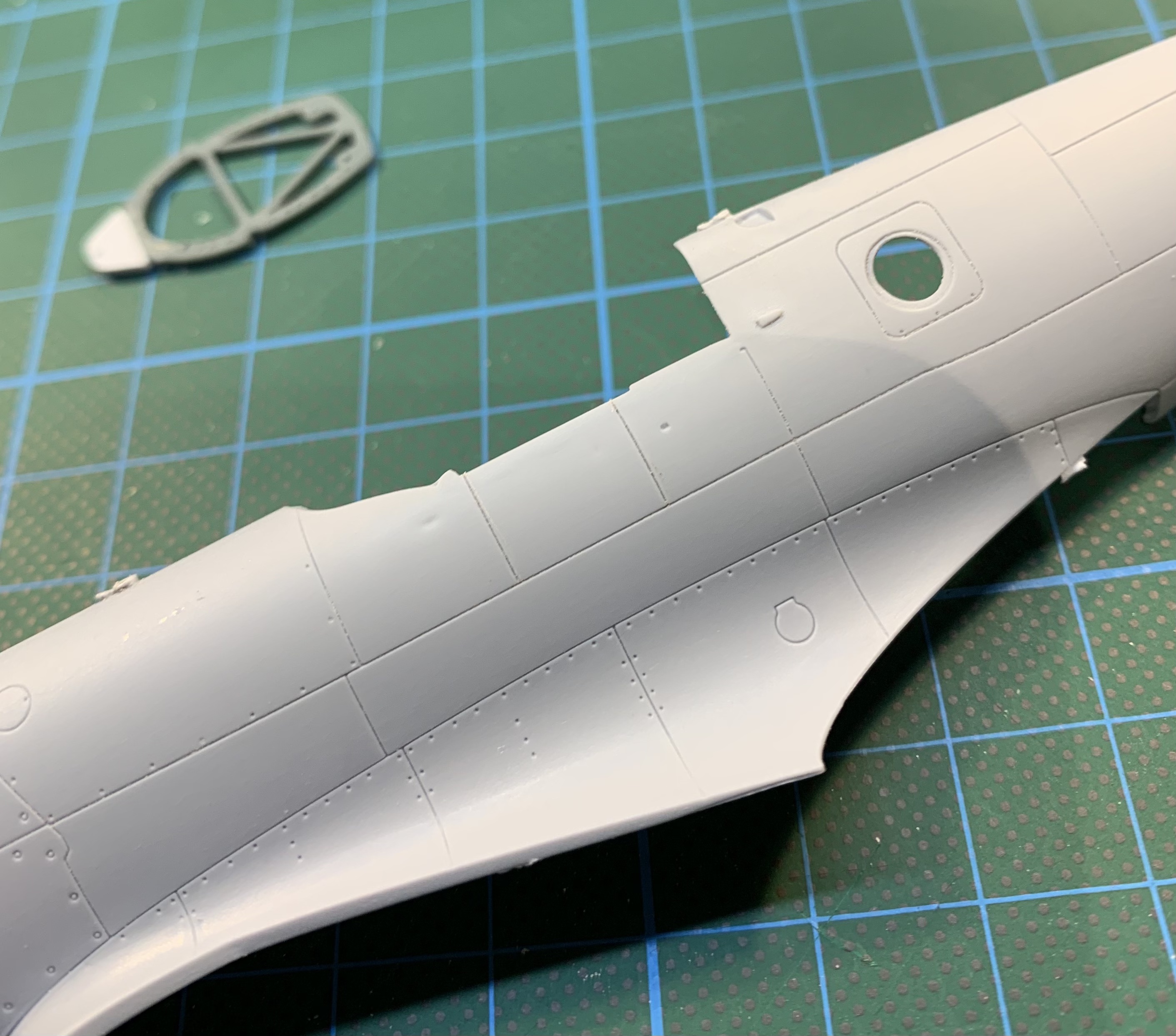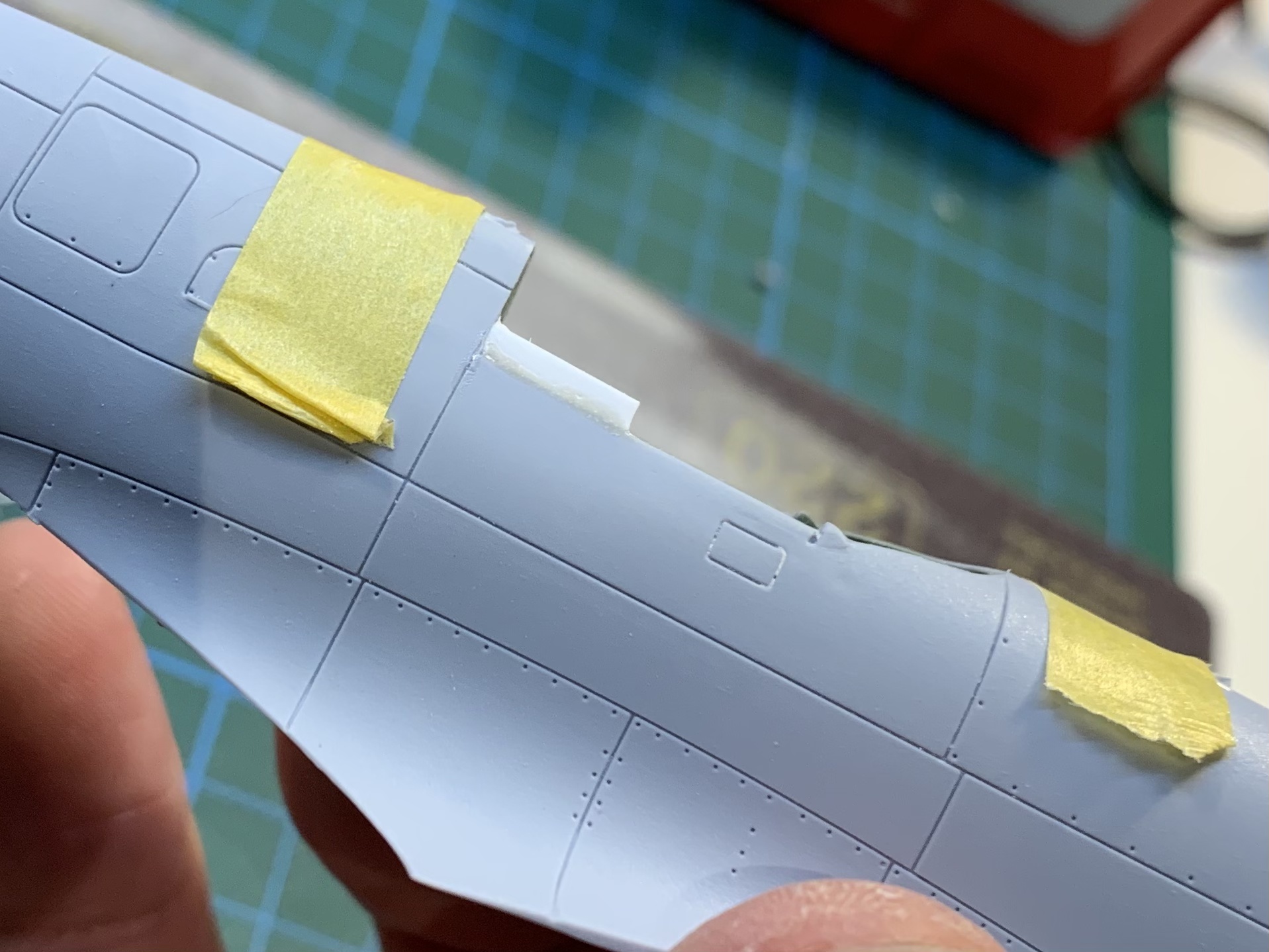- Introduction
- 6th October, 1944
- Squadron Leader Robert F. C. “Chris” Garvey DFC and Bar
- Airfix 1/48 Spitfire PR.XIX as F/L Garvey’s PR.XIX RM637
- Gallery
- References and Sources
Introduction
There is a remarkable story within the article “Alone, Above All” which I felt at the time deserved its own piece, and indeed committed to doing so at some point. While it may have taken me a couple of years to circle back the Flight Lieutenant Robert “Chris” Garvey’s exploits on the 6th and 7th of October 1944 in the featured Spitfire Mk.XIX, this piece is the fulfillment of that commitment.
6th October, 1944
On Friday the 6th October 1944 F/L R.F.C. Garvey flying a Spitfire PR.XIX (RM637) encountered heavy anti-aircraft fire while photographing Koblenz at only 6,500′. After completing his second run he saw two enemy Fw190s above and to the southwest of his position. He immediately opened up the throttle on his Griffen engined Spitfire in a climbing turn to the west. As he made the turn however, he noticed some form of vapour trail from the leading Fw190 which he assumed to indicate methanol injection was being used to boost its power.
Indeed, the enemy aircraft was able to close the range to only 700yds, opening fire as it did so. Garvey immediately pushed his unarmed Spitfire over into a tight spiralling dive in a desperate evasive manoeuvre but at least one of the Fw190s was able to pursue him downwards. Bottoming out the turn at zero feet and throttle wide open Garvey pulled his Spitfire’s nose up to avoid some trees, a manoeuvre the pursuing enemy aircraft was unable to match, exploding as it crashed into them. As the other Fw190 had not followed and was anyway nowhere to be seen, Garvey set course for home. For this remarkable feat of airmanship in downing an enemy aircraft by superior flying skills alone, F/L R.F.C. “Chris” Garvey was awarded a Bar to his D.F.C..

Garvey was in the thick of it again the next day. On the 7th, and flying the same Spitfire, his aircraft was struck in the tail by ground fire while on approach to the target, jamming his elevators for a short time. He was able to free some movement in them by “extreme pressure on the stick” and thereafter “was able to control the aircraft’s attitude by throttle” though it continued to fly in a tail-down attitude. His report expressed regret that due to this, his photos “would show a slant“.

Image Copyright: ©IWM
A version of the preceding narrative first appeared in the article posted elsewhere on this site entitled “Alone, Above all.”
Squadron Leader Robert F. C. “Chris” Garvey DFC and Bar
Sadly, there is very little information widely available on Robert Garvey. I was able to find his DFC and Bar citations as well as a brief report on the crash that took his life in 1948. He seems to have spent the war flying reconnaissance after transferring to the RAF from the Army and remained in the RAF when hostilities ceased.
22nd February 1944
GARVEY, Richard Francis Christopher, F/L (44811, Royal Air Force) – No.170 Squadron – Distinguished Flying Cross – awarded as per London Gazette dated 22 February 1944. Citation from Air Ministry Bulletin 12962. Served as 2nd Lieutenant in Royal Irish Fusiliers in 1939; commissioned in RAF, 1940. Home in London.
“Flight Lieutenant Garvey has taken part in a large number of operational sorties and photographic reconnaissances, achieving some excellent results. In June 1943, whilst on a shipping reconnaissance, he sighted and photographed a large convoy of enemy shipping as a result of which five enemy vessels were sunk. Recently this officer completed five special photographic missions very successfully. He has, at all times, displayed enthusiasm, courage and a fine fighting spirit.”
17th November, 1944.
The KING has been graciously pleased to approve the following awards in recognition of gallantry displayed in flying operations against the enemy.
Bar to Distinguished Flying Cross
Flight Lieutenant Richard Francis Christopher GARVEY, D.F.C. (44811), R.A.F., 541 Sqn.
“This officer has completed numerous reconnaissance sorties, setting an example of great courage and devotion to duty. In October, 1944, was detailed to obtain photographs of a certain objective. After completing his photographic runs Flight Lieutenant Garvey noticed two enemy fighters behind him Their leader opened fire. Flight Lieutenant Garvey spiralled almost to ground level, pulling out of his dive at the last moment. His attacker, who had followed him down, dived into a wood and burst into flames. This incident is characteristic of the skill and determination consistently displayed by this officer.“
14th January, 1948
NT552 Mosquito NF30, 44MU, RAF Shawbury, 1 killed
“The aircraft was on a ferry flight and on final approach to land, the port wing dropped, the aircraft yawed to port and dived steeply into the ground. The port wing struck first and the aircraft cartwheeled and disintegrated. It is suspected that the port engine did not pick up when the pilot advanced the throttles during the approach and this caused the initial wing drop and yaw. However, the break up of the aircraft made it difficult to determine the true cause of the loss. The pilot had an exceptional war record, as witness his DFC and Bar, and flew Mustangs and Mosquitos [sic], the latter in the photographic reconnaissance role. During one long range sortie, his unarmed aircraft was attacked by two enemy fighers but he descended to very low level and eventually applied his evasion tactics with such aggression that one of his pursuers flew into some trees.”
Squadron Leader Richard Francis Christopher GARVEY, DFC and Bar has a grave marker embedded in the wall at the Shawbury church with the following inscription.
In loving memory of
Squadron Leader
R.F.C. Garvey D.F.C. & Bar
Only son of J.C. & Gladys Garvey
Born at Murrisk Abbey 11th July 1918
Killed in a flying accident
at Shawbury, England,
on 14th January 1948 & buried there
Dearly loved
I found one reference that indicated Squadron Leader Robert F. C. “Chris” Garvey DFC and Bar was survived by his wife and young son.
Airfix 1/48 Spitfire PR.XIX as F/L Garvey’s PR.XIX RM637

Airfix’s 1/48 Spitfire PR.XIX builds relatively easily to a nice looking representation of the real thing. The engineering was intuitive and the fit was very good. There was only one issue to overcome, that being the inner flaps were much smaller than the space provided for them.
Of note however, is the kit out off the box is for a main production PR.XIX, the first production batch, albeit a small run, was built from what were essentially converted Mk.XIVs and did not have the pressurised cockpit.
Build
The changes necessary to create one of the early unpressurised PR.XIXs from the Airfix kit are relatively simple; fishtail exhausts to replace the kit-supplied round exhausts, four-spoke wheels in place of the five-spoke, scribe a cockpit entry door, a “standard” rear cockpit bulkhead, “standard” high back canopy and rear glass, a rounded windscreen without armour, and removal of the air intake on the port forward fuselage.
I used some aftermarket resin for the wheels and exhausts and adapted the Eduard bulkhead for use by splicing the kit part with it.
Much of the imagery below is focused on the conversions, including an image of the specific windshield type the PR.XIX used. The rear glass was the most difficult to get right but I was pleased with how it turned out. I used spares for the clear parts and adapted an Eduard rear fuselage bulkhead to replace the Airfix part.
Click on any of the images below to scroll through the gallery.

















By far the most time consuming part of the assembly were the conversations. The cockpit otherwise builds up nicely and I used only some Kitsworld 3D seatbelts to enhance it. The wings assembled very easily, needing just a little help to ensure the correct dihedral and seamless fit.
Paint
By 1944 PR Spitfires wore an overall PR Blue paint scheme. Painting such a monochrome scheme is relatively straight forward, though to achieve some texture I added a pre-shade. I mixed the PR Blue to match a fairly new, unfaded hue and applied. As Garvey’s RM637 was delivered in June I was painting it as it would have appeared in early October, some fading but not to the chalky appearance as older PR Blue faded to.
I added the underside invasion stripes and applied a slightly less faded PR Blue to represent where the upper stripes would have been overpainted in early July. The Squadron Summary of Events for October 1944 mentions that the stripes were totally covered up in October; as I am representing the airframe as it was on the 7th I decided to leave them on though of course it’s possible they were already painted over by then.
Click on any of the images below to scroll through the gallery.










Markings
The markings were simplicity itself, beginning with the wing walk lines. In terms of squadron and RAF markings, No. 541 Squadron’s PR Spitfires did not carry squadron letters so all that was required were the roundels and fin flash.

Image Copyright: ©IWM
The serial number was too small to cut a mask for so I used a generic RAF letter decal sheet. I also applied several of the applicable stencil decals using the image above as a guide.
Click on any of the images below to scroll through the gallery.





Weathering
I assumed very light weathering as 541S was operating from a home based airfield at Benson on Oxfordshire and would have the resources available to maintain and clean the aircraft appropriately. Consequently, I simply added a little staining for engine oil leaks and lubrication streaking on the control surfaces.
Click on any of the images below to scroll through the gallery.



Finish
After applying the final semi-flat finish the finishing touches were simple to complete; attach the undercarriage and doors and unmask the clear parts and attach the canopy.
Click on any of the images below to scroll through the gallery.






The Airfix kit was easy to work with and produces a fine model of the PR.XIX. If I had one complaint it would be the depth of the panel lines (“trench-like,” in the parlance of the typical review – they’re not that bad but are nonetheless over emphasised). To my eye they detract a little from the overall impression. If you want to know how much, I did not use a a panel line wash on this model at all (I usually only use it for control surfaces and access panels anyway), the kit’s panels are very visible anyway.
Gallery






















References and Sources
The references use for this piece are the same as those used for its parent article, “Alone, Above All” with the addition of the following specific to S/L R.F.C. Garvey.
If you are interested in following the build as it unfolded, as well as the research that led to the choice of markings, the full build diary is logged in the Britmodeller Aircraft WIP Section.
Copyright ©2023
This article, its text, and photos of the model is my original work and is protected by copyright in its entirety, except where noted. All research sources are listed in the References and Sources section above, including photos from official sources. All other images and quoted content were sourced from the internet and are used here under protection of fair-use. Any copyrighted content will be happily removed and/or credited forthwith upon request by its rightful owner.





Leave a comment